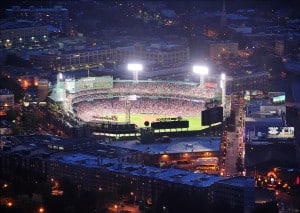Fenway Park
Year Built: 1912
Capacity: 37,731
Yankee Stadium
Year Built: 2009
Capacity: 47,442
The Yankees looked poised to steam home in their crucial revenue race with the Red Sox when the Bronx Bombers opened up a new $1.3 billion stadium in 2009. But eight years later, it’s the Red Sox who are having the last laugh, with antique Fenway Park, buffed up by a couple hundred millions dollars in renovations over the past 15 years, outperforming the Yankees too-big-to-succeed new stadium.
In the classic and never-ending debate over whether to renovate or tear down and rebuild, the decision of Sox owners John Henry and Tom Werner to fix up Fenway wins hands down over the Yankees’ gamble that new automatically equals better.
The Yankees hoped to pack in more high-paying fans. Instead, they have wound up with a first-class stadium debacle, with attendance at the new stadium having actually fallen by a stunning 18 percent since 2009.
And that’s just for the beginning. Suite and ticket revenue has plunged by an incredible $166 million since the stadium’s debut year in 2009, The New York Times reports, a drop made even more amazing given the stadium was built to cater to wealthy fans.
Yankees owner Hal Steinbrenner is professional sport’s version of a no-class developer who tears down an aging but sturdy and spacious old Victorian to replace it with a soulless multimillion-dollar McMansion.
In building a new stadium in the Bronx designed for Wall Street tycoons, not working- and middle-class fans, the Yankees violated a cardinal rule governing teardowns: know your neighborhood – or in this case, your market.
The new Yankee Stadium is actually a bit smaller than the old one, 47,442 seats compared to 56,882, though it remains considerably bigger than Fenway, where capacity is 37,731 for night games. But while the number of total seats went down, luxury perches for deep-pocketed fans skyrocketed, nearly tripling to 56, with the addition of 410 pricey “party suites” as well.
The new Yankee Stadium’s efforts to cater to Wall Street at the expense of everyday New York fans were on full display when the stadium opened in April 2009 with $2,500-a-game seats behind and near home plate.
But this slavish bid by the Yankees front office for the affections – and wallets – of franchise’s wealthiest fans backfired badly.
The high-priced seats by home plate quickly became an embarrassment when they turned up empty night after night, something apparent to fans watching the games on TV. The Yankees were soon forced to slash prices by half on those prime seats by home plate.
Since then, it has been all downhill, with a 42 percent loss in suite and ticket revenues since the stadium’s first year in business, according to the Times.

Yankee Stadium
If You Build It, They Will Come – If They Can Afford It
It’s not just the rich who have voted with their feet; higher prices have also squeezed out middle- and working-class fans. In a sign of the times, the Yankees recently began pushing $15 tickets in a bid to woo back the average Joe and Jill fan.
By contrast, Henry and his fellow Red Sox owners are bringing in far more money from Fenway Park today than when they closed their $700 million deal to buy the team in early 2002. And all for a fraction of what the Yankees spent on their new Taj.
Sox owners have laid out a total of $300 million since 2002 modernizing and modestly expanding old Fenway. The team has squeezed into the 1912 ballpark a few thousand additional seats over the past decade or so, boosting its capacity to well over 37,000.
By keeping the ballpark small the Sox have rarely struggled to fill masses of empty seats, even if their multiyear sellout streaks are now a thing of the past. As in the housing market, limited supply keeps prices up.
Now it is true that many, if not the majority, of the new seats have been luxury perches. However, unlike the Steinbrenner Yankees, John Henry’s Red Sox have at least avoided being glaringly crass in their pursuit of deep-pocketed fans, making it clear – with various initiatives and not just public relations pronouncements – that making sure average fans can still go to games is vitally important.
Looking at the numbers, it’s hard to argue that the Sox have not achieved a far better payback from their renovation of Fenway than the Yankees have with the massive amount of money they have blown on their new and unloved stadium.
At 47,442 seats the new Yankee Stadium may be 10,000 seats larger than Fenway Park, but so far this year the team is drawing an average crowd of 38,536. That’s just 3,000 more per game than Fenway; hardly a huge difference given Yankee Stadium’s much larger size.
Last season average Fenway ticket prices were higher, with Yankee Stadium having a slight edge this year, at $106 compared to $102.
It’s really hard to argue the Yankees – and New York taxpayers who helped subsidize the deal – got their money’s worth on the $1.3 billion spent on the new Yankee Stadium.
New is not always better. Sometimes it pays to renovate – and Fenway is possibly the best example out there of just why that is.









